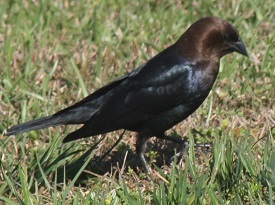(Molothrus ater)

The brown-headed cowbird is a member of the diverse blackbird family. They are referred to as “brood parasites” because the the female does not make a nest.
Males are glossy black body that can appear metallic green but have a brown head. Females are a drab brownish gray. Juveniles are also gray but their breasts are streaked and lighter in appearance. All have a thick, short (Finch-like) beak which is dark black. Legs and eyes are also a dark black. They are about 7 ½ inches long from beak to tip of the tail.
The the female does not make a nest. She lays her eggs in the nests of other species which then raise the young cowbirds. To find a host nest, the female cowbird will sit on a high perch in a forest opening to watch for nest-building birds. Once a nest is chosen, the cowbird female will either eat or destroy one of the host’s eggs before quickly laying one of her own. The young usually develop faster than the host young, and are larger and louder as well. The eggs usually hatch after 10-13 days, and the young fledge in 10-13 days. The young are raised by the host parents. They are not cared for by the Brown-headed Cowbird adults.
The Brown-headed Cowbird can be seen in almost every habitat, using open woodlands, fields, and the marginal habitat in between. It spends time foraging on the ground eating insects, seeds, grain, and fruits. This bird feeds in fields and is commonly associated with agriculture (cattle pastures, feed lots). The Brown-headed Cowbird is migratory, spending time year round in the southern United States, but occurring only during the breeding season in the northern and mountainous regions of the United States. Click on picture for more info.
Fun Facts:
The Brown-headed Cowbird is North America’s most common “brood parasite.” A female cowbird makes no nest of her own, but instead lays her eggs in the nests of other bird species, who then raise the young cowbirds.
Brown-headed Cowbird lay eggs in the nests of more than 220 species of birds. Recent genetic analyses have shown that most individual females specialize on one particular host species.
The number of eggs per breeding season varies, but brown-headed cowbirds may lay up to 77 eggs in one mating season.
Although the nests of many species are acceptable places for cowbirds to deposit eggs, all of those species are not necessarily appropriate hosts. Many parasitized species routinely recognize and reject cowbird eggs (by either destroying the egg, rebuilding the nest to cover the egg, or abandoning the nest), while many others are simply inadequate as foster parents and never successfully rear cowbird chicks. But the majority of hosts don’t recognize cowbird eggs at all.
Cowbird eggs hatch faster than other species eggs, giving cowbird nestlings a head start in getting food from the parents. Young cowbirds also develop at a faster pace than their nest mates, and they sometimes toss out eggs and young nestlings or smother them in the bottom of the nest.
Social relationships are difficult to figure out in birds that do not build nests, but male and female Brown-headed Cowbirds are not monogamous. Genetic analyses show that males and females have several different mates within a single season.
In winter, Brown-headed Cowbirds may join huge roosts with several blackbird species. One such mixed roost in Kentucky contained more than five million birds.
Historically, cowbirds followed herds of migrating bison to take advantage of the food they kicked up in their wake. They are still associated to an extent with large mammals such as cows. This led to the regional names of buffalo bird, cowbunting, cow blackbird and lazy bird.
A group of cowbirds are collectively known as a “corral” and a “herd” of cowbirds.

